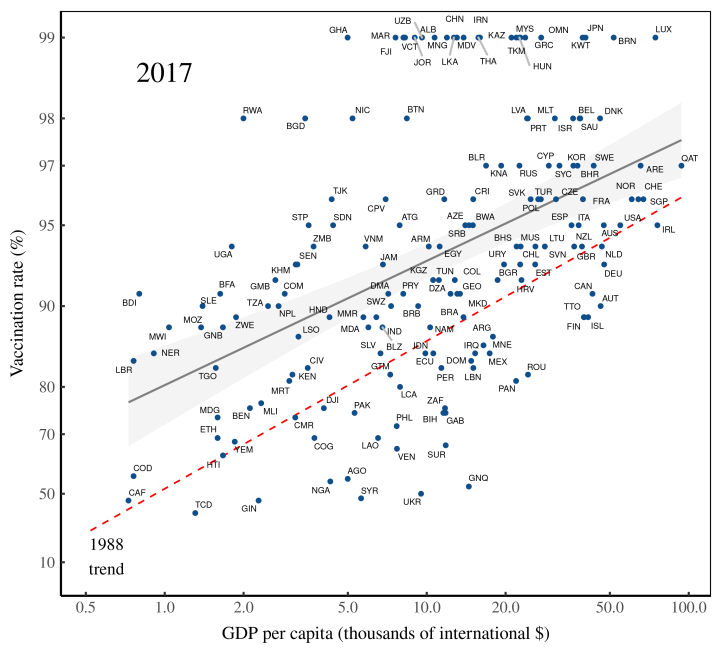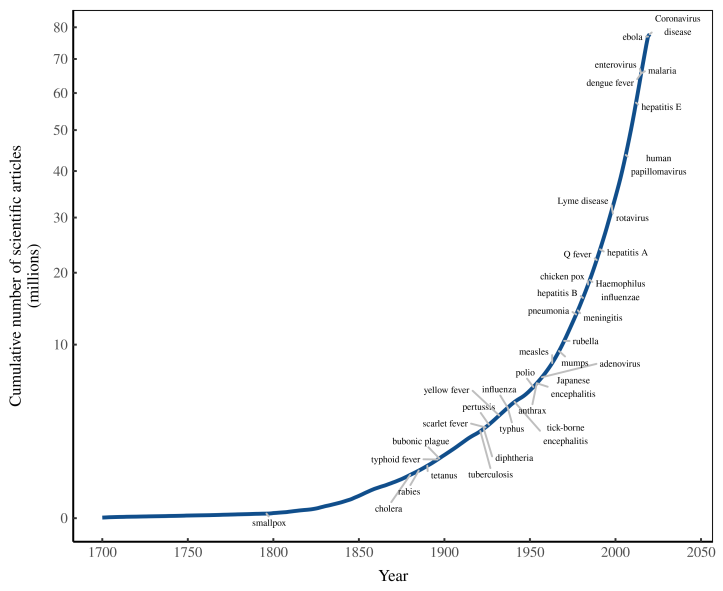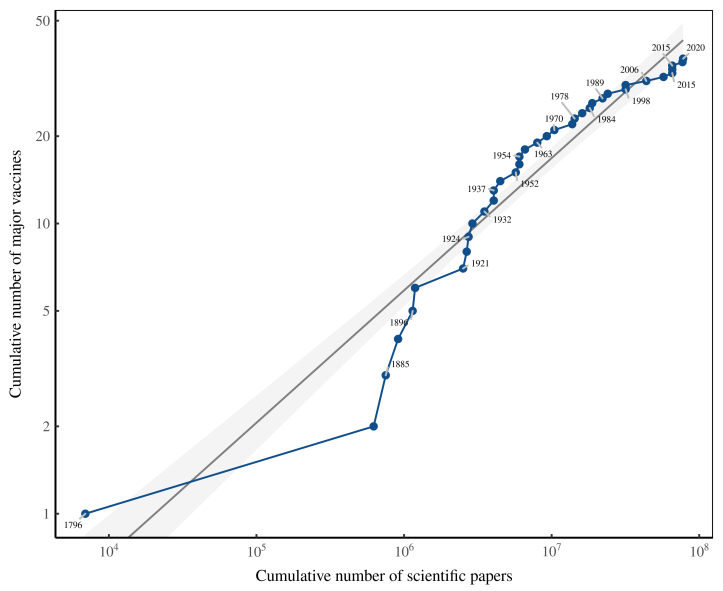From Blair Fix We’ve finally reached the end of 2020, a year that many people are happy to forget. In the history books, 2020 will be known for little besides the Covid pandemic. Fortunately, the end of this disaster is in sight. With multiple vaccines starting to roll out, it looks like 2021 will be a better year. Speaking of vaccines, I’ve been racking my brain to find things to be thankful for this holiday season. It’s not easy. My wife, daughter and I are in lockdown in Toronto. The rest of our extended families are in lockdown in Alberta and BC. So no family Christmas this year. I suspect it’s the same for many people. Fortunately, the Covid vaccine provides some light at the end of the tunnel. This is something to celebrate. But more than that, we should celebrate the whole
Topics:
Editor considers the following as important: Uncategorized
This could be interesting, too:
tom writes The Ukraine war and Europe’s deepening march of folly
Stavros Mavroudeas writes CfP of Marxist Macroeconomic Modelling workgroup – 18th WAPE Forum, Istanbul August 6-8, 2025
Lars Pålsson Syll writes The pretence-of-knowledge syndrome
Dean Baker writes Crypto and Donald Trump’s strategic baseball card reserve
from Blair Fix
We’ve finally reached the end of 2020, a year that many people are happy to forget. In the history books, 2020 will be known for little besides the Covid pandemic. Fortunately, the end of this disaster is in sight. With multiple vaccines starting to roll out, it looks like 2021 will be a better year.
Speaking of vaccines, I’ve been racking my brain to find things to be thankful for this holiday season. It’s not easy. My wife, daughter and I are in lockdown in Toronto. The rest of our extended families are in lockdown in Alberta and BC. So no family Christmas this year. I suspect it’s the same for many people. Fortunately, the Covid vaccine provides some light at the end of the tunnel. This is something to celebrate. But more than that, we should celebrate the whole enterprise that made the vaccine possible — science.
In the grand scheme of our species, it was not long ago that we believed infectious diseases were caused by ‘bad air’. The idea that germs cause disease became widely accepted only in the late 19th century, thanks largely to the work of Louis Pasteur. Vaccines are a similarly recent invention.
Our knowledge of infectious diseases is certainly something to celebrate. But as a political economist, I can’t help note how vaccination is stubbornly related to social inequalities. Vaccines are the ultimate public good — a life-saving device that is the product of our collective scientific effort. Predictably, though, this public good is not shared equally. In the last mile, vaccines are paywalled by private companies. So while in principle vaccines could be free for every human, in practice they are not. The result is that vaccination rates grow with income. The richer the country, the higher the vaccination rate. Here’s the relation in 1988.

Over the last 30 years, we’ve made progress in vaccinating the world’s population. Figure 2 shows the data in 2017. Relative to 1988, the vaccination rate has increased across all countries. Still, vaccination is a function of income. The richer the country, the more people get immunized.

Vaccines and cumulative scientific knowledge
When a pharmaceutical company patents a new vaccine, the logic is that they did the work … so they should reap the reward. True, the company probably did R&D and clinical trials. But this alone did not create the vaccine. At every step, the company built on existing scientific knowledge.
Take the Pfizer Covid vaccine. It’s the first vaccine to use RNA to produce an immune response. That’s a major achievement, but not one produced by Pfizer scientists alone. Just understanding the RNA molecule itself has been a century-long project that started in the 1930s. Every aspect of the Pfizer vaccine probably has similarly deep roots.
Vaccines are the product not of one company, but of our cumulative scientific knowledge. Figure 3 shows a way to visualize this fact. I’ve plotted here the growth of the cumulative number of scientific papers published over the last three centuries. Think of this corpus as humanity’s accumulated knowledge. Along the curve, I’ve labelled the dates of new vaccines. Unsurprisingly, new vaccines have come as our scientific knowledge exploded.

True, only a tiny fraction of scientific papers are directly related to immunology. But knowledge is like the tree of life. As you trace it backwards, it becomes clear that there is only one tree. Here’s a way to think about it. Suppose that an article about a vaccine trial references 45 other papers. Each of these papers in turn cites 45 papers … and so on. At this rate, after 6 generations of articles the web of citation reaches 83 million papers (456). That’s roughly the whole of the scientific corpus.
Because vaccines are a product of our cumulative knowledge, the number of major vaccines scales with the cumulative number of scientific papers. Figure 4 shows the trend.

What’s interesting is that the trend is non-linear. The cumulative number of vaccines grows roughly with the square root of the cumulative number of papers:
What this means is that over time, producing new vaccines becomes more knowledge intensive. That’s not surprising. The first vaccine was discovered by accident. In 1796, the British doctor Edward Jenner found that getting infected with cowpox (a mild disease) conferred immunity to smallpox. The smallpox vaccine was born. (Side note: vaccines owe their name to this cowpox discovery. The word ‘vaccine’ comes from vacca, the Latin word for cow.)
As time went by, the development of new vaccines became less serendipitous. The polio vaccine, for instance, was a massive public health effort. In 1954, the Salk vaccine was tested on 1.8 million US children. That’s hardly a small-scale operation.
We see this kind of trend throughout science. Three centuries ago, Isaac Newton did basic science using inclined planes. Today, physicists do basic science using billion-dollar particle accelerators. As science advances, new discoveries become more intensive, both in terms of resources and prior knowledge.
And that brings me back to paywalls. It’s a crime when vaccines get paywalled in the last mile. But it’s also a crime when scientific knowledge gets paywalled. Here, however, we have something to celebrate. In principle, the vast majority of scientific papers are paywalled. But in practice, almost all scientific knowledge is freely available on the internet. That’s thanks largely to one renegade scientist — Alexandra Elbakyan. She created the Sci-Hub database that now houses more than 80 million scientific articles, all available for free. It’s these Sci-Hub papers that I’ve plotted in Figure 3.
As we head into 2021, let’s be thankful for the Covid vaccine. But let’s also be thankful that for the first time in history, virtually all scientific knowledge is available for free. That’s something to celebrate.
